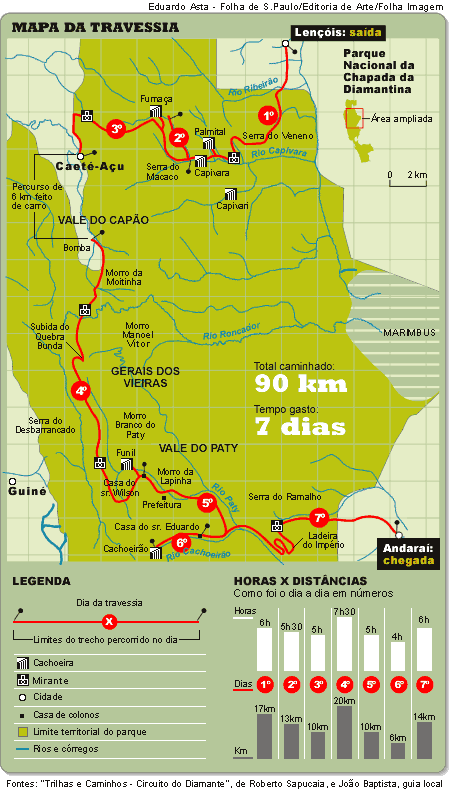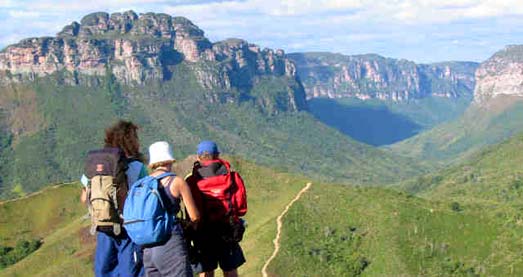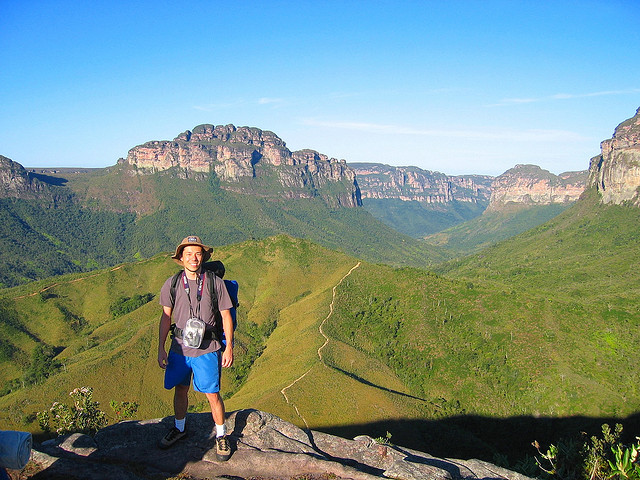Este post também está disponível em:
Português
English

The Chapada Diamantina National Park offers several trekking trails in canyons, caves, steep hills, huge waterfalls, bromeliads and coca cola colored rivers.
Lençóis is the city that receives the most tourists, it is full of charm, inns and delicious restaurants.
Igatu, a pre-Columbian city, is known as the Brazilian Machu Picchu and is full of stones and ruins, of the old mining that reigned the region.
Mucugê, listed by the National Historical Heritage, has a cinematographic Byzantine cemetery, and Vale do Capão, is a very cozy village that accommodates people from all over the world.
The Capão Valley is also the starting point for one of the most beautiful trekking in Brazil, the crossing of the Pati Valley.
Andaraí is a small wetland in the middle of the savannah, while Ibicoara hides, in the south of the park, two impressive waterfalls, Buracão and Fumacinha.
It is impossible to go only once to Chapada and know all the places. Make Chapada the paradise of your adventure!

Videos about the Trekking through Chapada Diamantina

Trekking – Route through Chapada Diamantina in 7 days
1st day
From Lençóis, you head towards Ribeirão do Meio. After about two hours of heavy climbing, you reach the top of the Veneno mountain range, 2 km from Ribeirão. You cross the Muriçoca River to the Onça burrow, with a stop for rest and snack.
From there, walk towards the waterfalls of Palmital and Capivara.
The first night is spent at the Capivara waterfall. When the weather is good and the river is low, it is possible to sleep outdoors on a stone slab in the den.
2nd day
Leave the burrow and go up the Capivara River to the Fumaça River, a journey of about one hour and 30 minutes.
Backpacks and tents are left at the Fumaça lair.
Taking only swimwear and snacks, you continue along the Fumaça River and in two hours you reach the waterfall, in the lower part. Return along the Fumaça riverbed to the burrow, where the tents are pitched.
3rd day
Next to the Fumaça hole is the Serra do Macaco, one of the worst climbs of the trek.
It is about 4 km of ascent covered in three hours. The stop for rest and lunch is made at the well of the Sanctuary.
From there, you go to the “mouth” of the Fumaça waterfall and to the viewpoint, where you can see the waterfall.
You walk through a flatter and less tiring region to the Capão valley. In Caeté-Açu, visitors usually sleep in inns and eat in family houses.
4th day
To facilitate the journey, visitors usually rent a 4×4 car, with driver, to Bomba (6 km away). From this point, you walk up to Gerais do Vieira.
After a long stretch of straight and exuberant landscape, you arrive at “Desbarrancado”. After extremely steep descents and ascents, you finally reach the Pati valley.
Traditionally, visitors sleep in family houses in the region, where, despite the simplicity, they are served abundant and tasty meals. Among them the house of the couple Wilson and Maria.
5th day
Without a backpack, visitors go to the Funil waterfall. On the way back, they collect their luggage at the homes of local residents and walk down the Paty River towards Castelo Hill, where the city hall is located, currently deactivated.
The city hall building and Mr. Eduardo’s house are the two lodging options on this stretch.
6th day
From the town hall or Mr. Eduardo’s house, walk to the Cachoeirão, which has a 20-meter drop. Crossing the forest next to the Cachoeirão, you reach the potion, where you can dive and swim.
This is the lightest day of the trail. It takes two hours to go and two more to return to Mr. Eduardo’s house.
7th day
Leaving Mr. Eduardo’s house, you cross the Pati River and go up the Ladeira do Império, a trail used in the past to transport the coffee produced in the valley, to Andaraí.
See also “Where to stay, how to get there and tips about Chapada Diamantina”.
Bahia.ws is the largest tourism and travel guide for Bahia and Salvador.




















